Ecclesdown Road, Jamaica
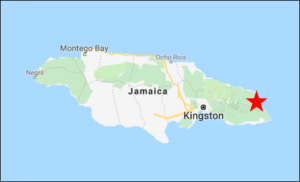
Tucked away in the verdant foothills of the John Crow Mountains, Ecclesdown Road is one of the best birdwatching sites in the Caribbean. This lush forest is the only known site where all of Jamaica’s endemic bird species have been found, and most can be observed easily during a morning’s outing. Black-billed and Yellow-billed Parrots flock together, Jamaican Crows jabber and chortle across the valley while Jamaican Blackbirds madly demolish the bromeliads, and Black-billed Streamertails defend against incursions of their Red-billed cousins.
Orientation
Directions
The north end of Ecclesdown Road is about 45 minutes east of Port Antonio, which is a regional capital (of Portland Parish) and major port, on the main coastal highway, Route A4.
The south end of Ecclesdown Road is about two-and-a-half hours’ drive (90 km) east of Kingston. When arriving from the south, the productive part of Ecclesdown Road begins about 12 km up the road.
From Port Antonio to the North End. Take the A4, east through San San, Fairy Hill, and Boston Beach. 6 km past Boston Beach, at the High Roller Trucking & Block Factory, turn right onto the road to Fair Prospect High School, and go 1.1 km to the junction with Ecclesdown Road (on the left, unmarked).
From Kingston to the South End. Take the A4 (Norman Manley Boulevard) east through Harbour View, Yallahs, Morant Bay, and beyond. 80 km past the Harbour View roundabout, in the village of Long Road, the A4 bends strongly to the left overlooking the mouth of a small river. 700 m past the bend, turn left onto Ecclesdown Road (signposted for Reach Falls).
Attractions
Reach Falls. The scenic swimming area at Reach Falls is the best known landmark on Ecclesdown Road—better known than the road. This site enjoyed a surge of popularity after appearing in the Tom Cruise bartending movie, Cocktail. The turn-off to the falls is about 3 km from the south end, just south of the village of Reach. As with many Jamaican tourist attractions, there is a surprisingly high entrance fee: U.S.$10 per person (at last report).
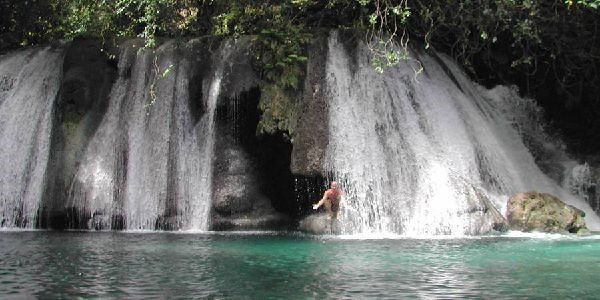
Reach Falls, on Ecclesdown Road.
Long Bay Beach. The mile-long strand of Long Bay Beach begins about 2 km south of the north end of Ecclesdown Road. It is a beautiful beach that is undeveloped and usually empty.
Hector’s River. When approaching from the south, about 4 km before the junction with Ecclesdown Road, the A4 passes through the villages of Happy Grove and Hector’s River, where it is possible to see breeding “Atlantic White-tailed Tropicbird” (at a distance).
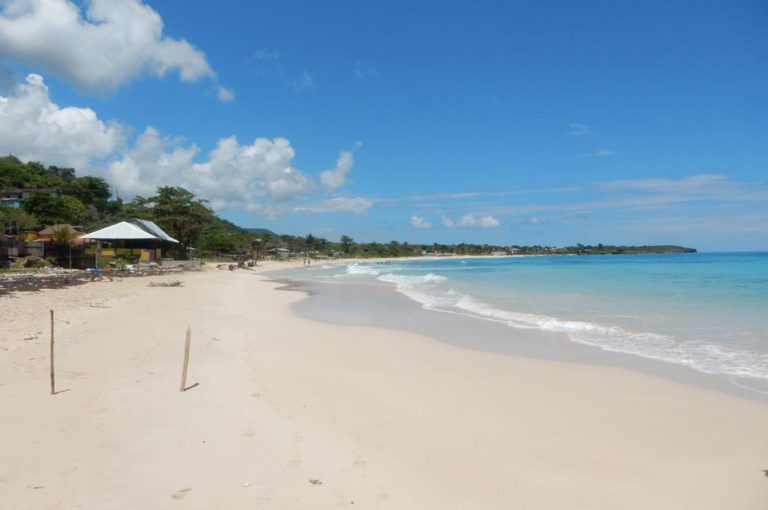
Long Bay Beach.
Birdfinding
The best part of Ecclesdown Road is a 5 km segment near the north end. At the junction, set your odometer to zero.
From around 2.5 km to 5 km, you will pass through fragments of tall lowland forest with banana and coconut plantations. This stretch is particularly good for Ring-tailed Pigeon, Jamaican Lizard-Cuckoo, Black-billed and Yellow-billed Parrots, and Jamaican Crow. There are several good vantage points over the valley to the west, where the crow and parrots are often easy to detect and see at a distance as they fly around calling loudly.
The most productive portion is usually the highest stretch of the road: from about 5 km to the crest, at 7.5 km, where there is more intact habitat and the forest has more epiphytes. This is the best area for most of the uncommon or localized endemics: Crested Quail-Dove, Small Jamaican Elaenia, Blue Mountain Vireo, and Jamaican Blackbird.

Ecclesdown Road, north end. The best part is 2.5 to 7.5 km.
Although Ecclesdown Road has the potential to produce every one of Jamaica’s endemics, some are scarce or sporadic. Large Jamaican Elaenia is only a rare winter visitor, Jamaican Owl would obviously require a special effort, and Red-billed Streamertail is outside of its described range (it occurs here, but perhaps not continuously). Jamaican Crow is usually easy to find, but the population in the John Crow Mountains is a small, isolated group that appears to be declining and may soon disappear.
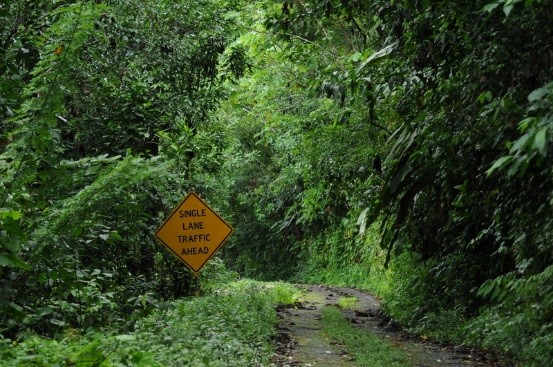
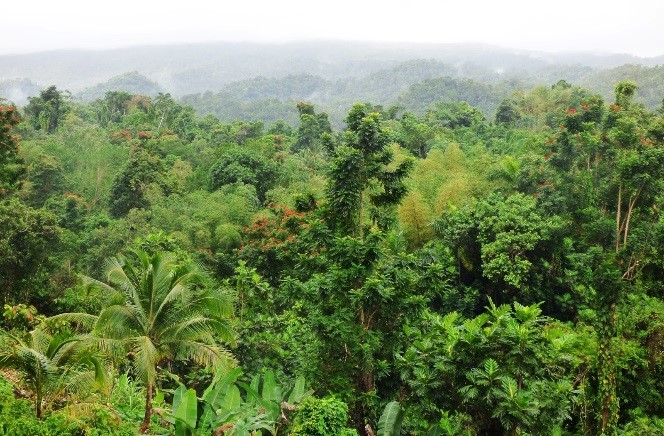
If arriving from the south, be aware that the first 12 km pass through thinly settled agricultural land, the dispersed village of Reach, and the turn-off to Reach Falls. It can be good for open country birds such as “Caribbean Black Swift,” Antillean Palm Swift, Green-rumped Parrotlet, and Jamaican Parakeet, but not for the specialties. If visiting at night, the southern portion is good for “White-winged Barn Owl.”
For most visitors, however, it is advisable to pass through the southern portion of the road without stopping until reaching the crest (the 7.5-km point indicated above).
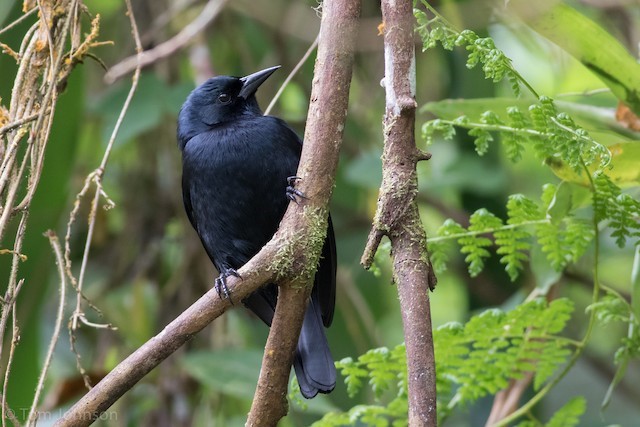
Jamaican Blackbird. © Tom Johnson
Distressing News. As of 2018, Ecclesdown Road is losing its glory. Perhaps it is not yet fair to call it a shadow of its former self, but the habitat immediately adjacent to the road has deteriorated. Most of the area has long been a patchwork of cultivation and forest, and this ratio has not changed much, but there has been significant clearing of brush and trees along the road itself—possibly to allow for trucks and large equipment to widen or resurface it. As a result, sections that were formerly closed-canopy are now open and will remain that way for many years. Specialties such as Crested Quail-Dove and Jamaican Blackbird are becoming harder to find.
For Jamaica, the degradation of one of its ecotouristic gems seems to be a self-inflicted wound with no obvious rationale.
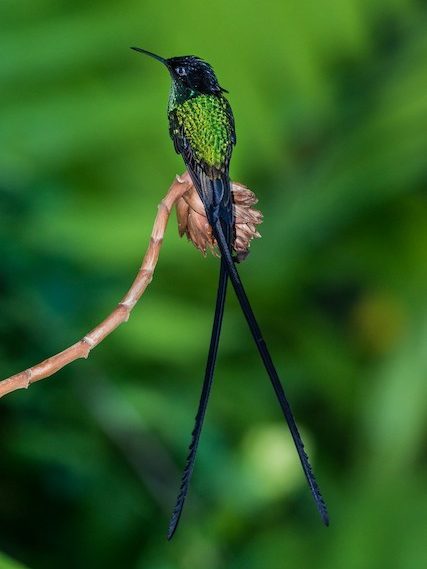
Male Black-billed Streamertail at Ecclesdown Road. © Li Li
Services
Accommodations
Most birdwatchers who visit Ecclesdown Road stay overnight in Port Antonio or San San, but there are other options in the vicinity, some quite economical and closer to Ecclesdown.
At Boston Beach, Great Huts Resort is a bohemian compound of unique cabanas, with on-site cliff-diving. This unusual hotel is the project of a Washington, D.C.-based doctor, Paul Rhodes, who has led several philanthropic efforts in Jamaica. It is worth visiting just to behold.
In the village of Long Bay, 3 km south of the north end of Ecclesdown Road, the Pimento Lodge Hideaway Resort is a comfortable hillside retreat.
Farther south, along Route A4 between Long Bay and Manchioneal, about equidistant (7 km; 15 minutes) from the north and south ends of Ecclesdown Road, are two hotels dramatically situated on seaside cliffs: the Hotel Jamaican Colors and the more upscale Sea Cliff Hotel with its acclaimed Cliffhanger restaurant.
In Hector’s River, for a room with a view (a distant view) of a tropicbird colony, the guesthouse Villa Juanita is just 3 km south of the south end of Ecclesdown Road.
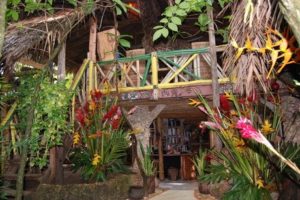
Great Huts Resort.
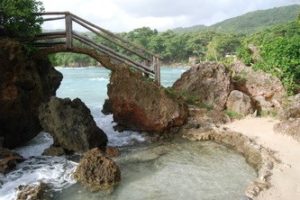
Great Huts Resort.
Food
Along Route A4 between Long Bay and Manchioneal, about equidistant (7 km; 15 minutes) from the north and south ends of Ecclesdown Road, the Cliffhanger restaurant makes a good curry goat—and tropicbirds can sometimes be seen from its tables.
The fabled birthplace of jerk cuisine, the Boston Jerk Center, is on Route A4 beside Boston Beach, a 20-minute drive east of San San. The venerable Jerk Center is a cluster of artisanal barbecue pits under corrugated roofs near the site of the world’s first commercial jerk pit. Two of the current pits date back to the first generation: Ivy’s and Shaggy’s.
It is important for foreign visitors to know “that the way these Jerk centres charge customers are often unregulated and even discriminatory—specifically toward tourists. So the trick is to always ask the prices of things before you buy. And if you have no problem with this, all will be fine. Failure to do this will lead to them tricking you. You have been warned.” (Thanks to PrissyTroopers!)
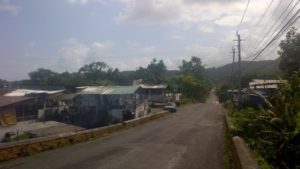
The Boston Jerk Center, on Route A4.
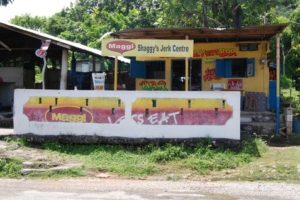
Shaggy’s Jerk Pit.
Notes
Some of the local residents illegally hunt pigeons and doves along Ecclesdown Road from time to time, disturbing the peace and the birds. To do this, they carry guns, of course, which can be unnerving, but there is generally no reason to expect trouble.